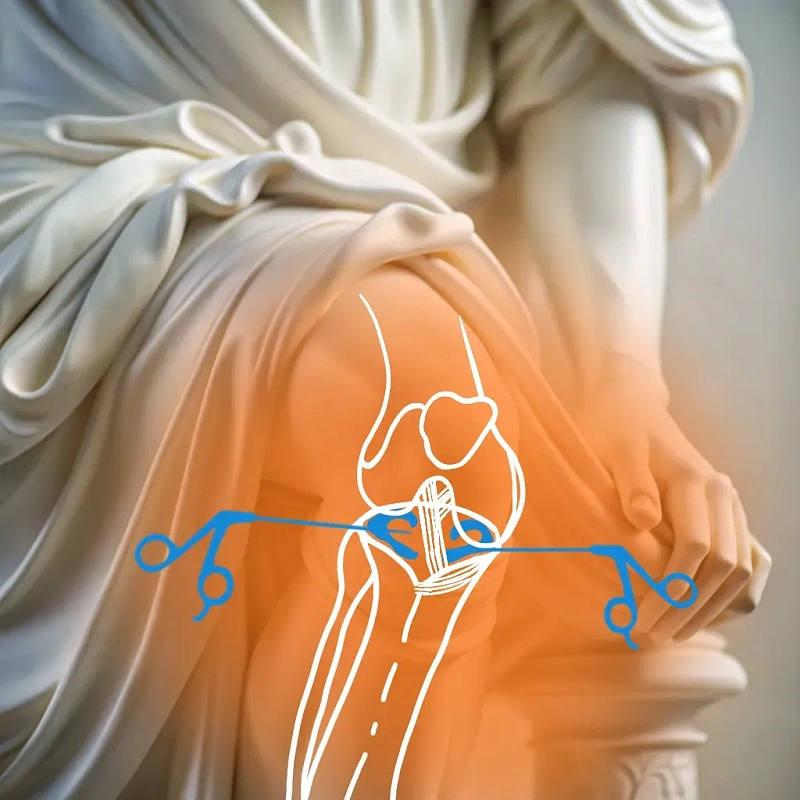Arthroscopy of the knee joint
Knee arthroscopy is a minimally invasive surgical procedure for the diagnosis and treatment of injuries and diseases of the knee joint. It allows examining the joint for damage and eliminating the identified defects.

This procedure is necessary in cases of meniscus damage, cysts, ligament injuries, inflammation of the synovial membrane, cartilage damage, deforming arthrosis, rheumatoid arthritis and intraarticular fractures.
The knee joint is constantly under heavy stress, so many people wear out by the age of 45-50. Joint wear leads to chronic knee pain, and knee arthroscopy is becoming the most effective treatment method. Arthroscopy helps to reduce pain, improve joint function and improve the quality of life of patients. During the operation, the surgeon uses an arthroscope, a special device with a camera at the end. Through it, the doctor sees the joint and instruments inserted through other small punctures in multiple magnification on the screen. This allows him to accurately perform the necessary manipulations.
Common blood and urine tests CT and MRI of the knee joint Consultations with a general practitioner, an anesthesiologist, and specialized physicians
Through a small puncture, the doctor inserts an arthroscope to diagnose the condition of the joint. After identifying the damage, the surgeon makes the necessary number of additional punctures and, using special tools, eliminates defects in the knee joint and restores damaged structures.
An arthroscope, an instrument with a camera that can zoom in and display a detailed image of the joint. Special medical tools allow precise surgical manipulation through small punctures.
Post-arthroscopy recovery depends on the extent of the surgery performed. To speed up rehabilitation, the attending physician may recommend a physiotherapist's consultation, where you will be prescribed physiotherapy.
Benefits
Accurate diagnosis and effective treatment
The operation allows you to diagnose with an accuracy of about 95% and prescribe the best treatment for knee joint injuries.
Good cosmetic effect
The operation is performed through 2-3 small punctures, after which almost imperceptible postoperative scars remain.
Rapid recovery after surgery
Arthroscopy allows you to shorten the period of stay in the hospital and accelerate the recovery period after surgery.
Minimal injury
The absence of large incisions and damage to healthy tissues of the knee joint.
Frequently Asked Questions
Under what anesthesia is the operation performed?
How long does knee arthroscopy last?
Didn't find an answer to your question?
You can describe your problem in detail and ask a question to the doctor. He will answer you and help you find a solution
Врачи
Смотреть всех врачейSimilar referral activities
Arthroscopy of the ankle joint
Ankle arthroscopy is a minimally invasive surgical procedure used to diagnose and treat various diseases and injuries of the ankle joint.
Arthroscopy of the elbow joint
Arthroscopy of the elbow joint is a minimally invasive surgical intervention that allows for accurate diagnosis and simultaneous treatment of joint injuries.
Arthrodesis of the joints of the fingers of the hand
The destruction of the joints of the fingers of the hand is accompanied by pronounced pain and impaired functions. Arthrodesis is a surgical intervention in which the affected joint is completely immobilized, which relieves pain and progression of inflammation.
Arthroscopic revision of the cystic joint
The condition of the wrist joints determines the functioning of the hand. Arthroscopic revision is a minimally invasive diagnostic procedure that assesses the condition of the joint tissues, which is necessary for planning subsequent treatment.
Arthroscopy of the shoulder joint
Arthroscopy of the shoulder joint is a minimally invasive surgical procedure designed to diagnose and treat various diseases and injuries of the shoulder joint.
Hip arthroscopy
Hip arthroscopy is a minimally invasive surgical procedure that allows the examination and treatment of hip joint pathologies through small incisions.